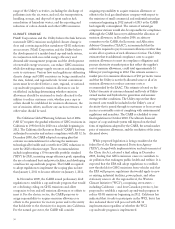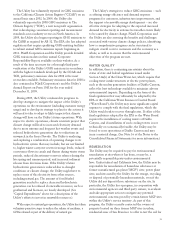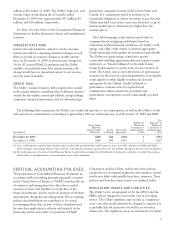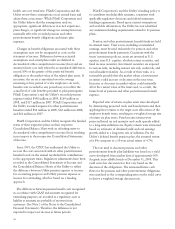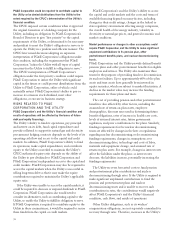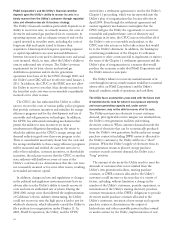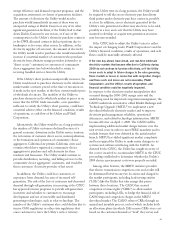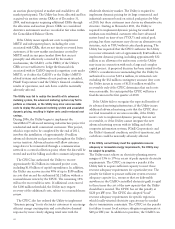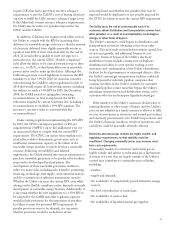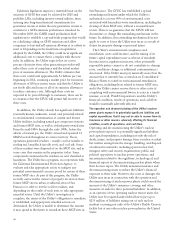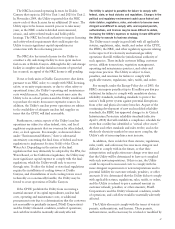PG&E 2009 Annual Report Download - page 43
Download and view the complete annual report
Please find page 43 of the 2009 PG&E annual report below. You can navigate through the pages in the report by either clicking on the pages listed below, or by using the keyword search tool below to find specific information within the annual report.workers’ compensation liabilities and other unfunded
liabilities caused by a decrease in the applicable discount
rate negatively impact net income.
The Utility’s revenues, operating results, and financial
condition may fluctuate with the economy and the economy’s
corresponding impact on the Utility’s customers.
The Utility is impacted by the economic cycle of the
customers it serves. The declining economy in the Utility’s
service territory and the declines in the values of residential
real estate have resulted in lower customer demand and
lower customer growth at the Utility, and an increase in
unpaid customer accounts receivable. Increasing
unemployment could further reduce demand as residential
customers voluntarily reduce their consumption of
electricity in response to decreases in their disposable
income. A sustained downturn or sluggishness in the
economy could reduce the Utility’s sales to industrial and
commercial customers. Although the Utility generally
recovers its costs through rates, regardless of sales volume,
rate pressures increase when the costs are borne by a
smaller sales base.
The completion of capital investment projects is subject to
substantial risks, and the rate at which the Utility invests and
recovers capital will directly affect net income.
The Utility’s ability to develop new generation facilities
and to invest in its electric and gas systems is subject to
many risks, including risks related to obtaining regulatory
approval for capital investment projects, securing adequate
and reasonably priced financing, obtaining and complying
with the terms of permits, meeting construction budgets
and schedules, and satisfying operating and environmental
performance standards. Third-party contractors on which
the Utility depends to develop these projects also face
many of these risks. The development of proposed Utility-
owned renewable energy projects may also be affected by
the extent to which necessary electric transmission facilities
are built and evolving federal and state policies regarding
the development of a “smart” electric transmission grid.
Changes in tax laws or policies, such as those relating to
production and investment tax credits for renewable energy
projects, may also affect when or whether the Utility
develops a potential project. In addition, reduced
forecasted demand for electricity and natural gas as a result
of the slowing economy may also increase the risk that
projects are deferred, abandoned, or cancelled.
In addition, the Utility may incur costs that it will not
be permitted to recover from customers. The Utility’s
amount and timing of capital expenditures can be affected
by changes in the economy that impact customer demand
and the rate of new customer connections. If capital
spending in a particular time period is greater than assumed
when rates were set, earnings could be negatively affected
by an increase in depreciation, taxes, and financing interest
and the absence of authorized revenue requirements to
recover an ROE on the amount of capital expenses that
exceeds assumed amounts.
PG&E Corporation’s investment in new natural gas
pipeline projects is subject to similar risks and, in the case
of the proposed Pacific Connector, is subject to the
development of a proposed liquefied natural gas storage
terminal by third parties. In addition, pipeline project
development is conditioned on obtaining certain levels of
capacity commitments from shippers. Many of these
conditions must be satisfied by PG&E Corporation’s
investment partners.
PG&E Corporation’s and the Utility’s financial statements
reflect various estimates, assumptions, and values; changes to
these estimates, assumptions, and values — as well as the
application of and changes in accounting rules, standards,
policies, guidance, or interpretations — could materially affect
PG&E Corporation’s and the Utility’s financial condition or
results of operations.
The preparation of financial statements in conformity with
GAAP requires management to make estimates and
assumptions that affect the reported amounts of revenues,
expenses, assets, and liabilities, and the disclosure of
contingencies. (See the discussion under Note 1 of the
Notes to the Consolidated Financial Statements and the
section entitled “Critical Accounting Policies” in the
MD&A.) If the information on which the estimates and
assumptions are based prove to be incorrect or incomplete;
if future events do not occur as anticipated; or if there are
changes in applicable accounting guidance, policies, or
interpretation, management’s estimates and assumptions
will change as appropriate. A change in management’s
estimates or assumptions, or the recognition of actual
losses that differ from the amount of estimated losses,
could have a material impact on PG&E Corporation’s and
the Utility’s financial condition and results of operations.
For example, if management can no longer assume that
potentially responsible parties will pay a material share of
the costs of environmental remediation or if PG&E
Corporation or the Utility incurs losses in connection with
environmental remediation; litigation; or other legal,
administrative, or regulatory proceedings that materially
exceed the provision it estimated for these liabilities, PG&E
Corporation’s and the Utility’s financial condition, results
of operations, and cash flow would be materially adversely
affected.
39



